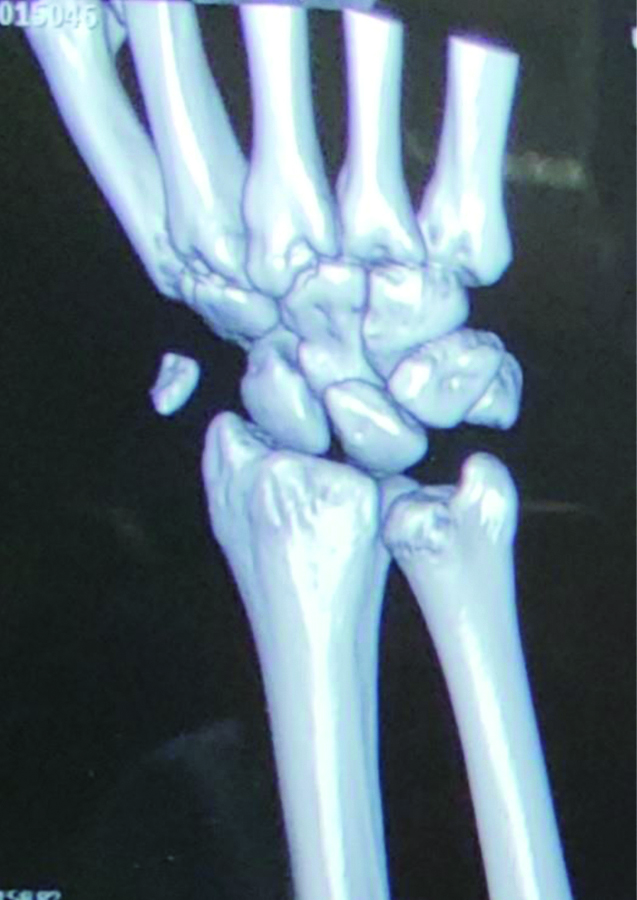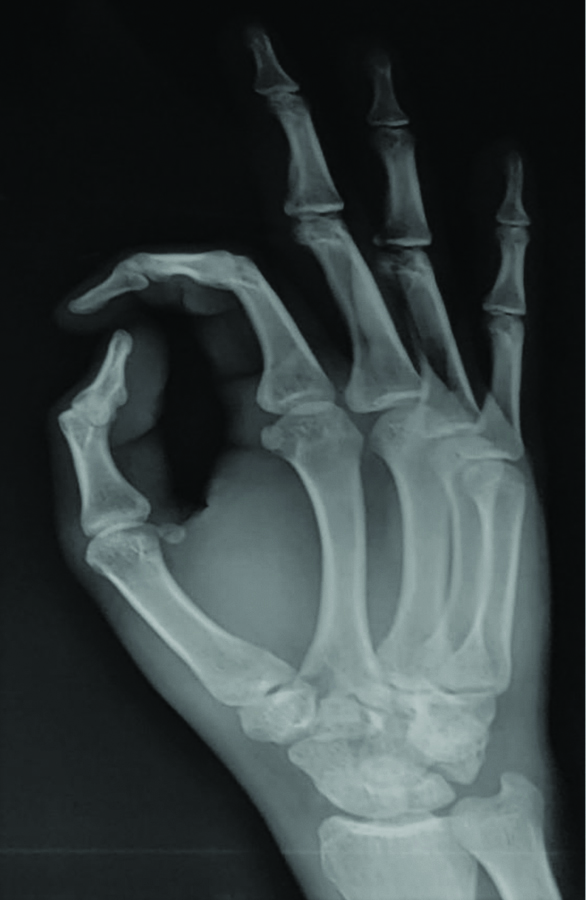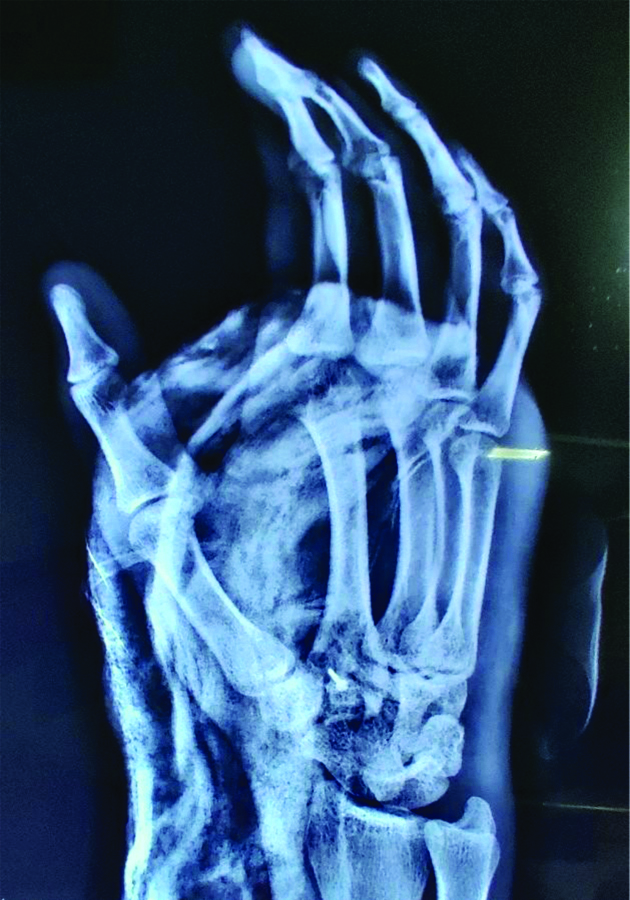Second Metacarpal Base Avulsion Fracture Due to the Extensor Carpi Radialis Longus Tendon: A Case Report
Tanvi Rao1, Jonathan Victor2
1 Senior Resident, Department of Plastic Surgery, Pondicherry Institute of Medical Sciences, Pondicherry, India.
2 Associate Professor, Department of Plastic Surgery, Pondicherry Institute of Medical Sciences, Pondicherry, India.
NAME, ADDRESS, E-MAIL ID OF THE CORRESPONDING AUTHOR: Dr. Tanvi Rao, Senior Resident, Department of Plastic Surgery, Pondichery Institute of Medical Sciences, Kalapet-605014, Pondicherry, India.
E-mail: raoatanvi@gmail.com
Fracture avulsion injuries of the extensors of the wrist are not common. The most common mode of injury is forced flexion of the hand and wrist with Extensor Carpi Radialis Longus (ECRL) contraction at the same time. These fractures are generally managed by Open Reduction and Internal Fixation (ORIF) along with repair of the ECRL tendon. This modality of management is associated with less chance of complications, makes the joint more stable and has an overall positive result.
Carpometacarpal,Chip fracture,Metacarpal fracture
Case Report
A 27-year-old male patient presented with polytrauma (right shaft of femur fracture, left volar Barton fracture, base of left fifth metacarpal fracture) due to a high velocity road traffic accident. Initial resuscitation done according to acute trauma life support protocol. Secondary survey showed swelling over the dorsum of the right hand. Clinical examination showed painful wrist extension and no rotational deformity of the index finger. Radiographs and Computed Tomography (CT) scans showed an avulsion fracture of the base of the 2nd metacarpal, with the fractured chip pulled down to the proximal row of carpal bones [Table/Fig-1,2].
CT scan showing avulsion fracture of the base of the 2nd metacarpal with the fractured chip pulled down to the proximal row of carpal bones.

X-ray of the hand showing avulsion fracture of the base of the 2nd metacarpal.

He was taken up for ORIF of the fracture. The procedure was done under general anaesthesia as the other fractures were being fixed by the orthopaedic team in the same setting. A longitudinal 4 cm incision on the dorsal aspect in the region of the base of 2nd metacarpal was made to gain access to the fracture site. The fractured segment of the bone was found to be avulsed along with the ECRL tendon and found in the region of the proximal row of carpal bones. The ECRL tendon was released along with the fractured segment and pulled distally over the base of the 2nd metacarpal. The ECRL tendon was repaired by taking sutures to the remnant tendon at the base of the 2nd metacarpal. The fracture was then reduced and fixed with one 1.5 mm×12 mm titanium screw and the ECRL tendon was repaired. Postoperatively the fracture reduction was satisfactory as noted on the postoperative chest X-ray [Table/Fig-3]. The wrist was immobilised in 25° extension by splinting for six weeks. Physiotherapy was initiated after this. In three months follow-up, he is having full, painful range of movements.
Postoperative X-ray showing good reduction of the fracture of the base of the 2nd metacarpal after screw fixation.

Discussion
Second metacarpal base articulates with the trapezium, the trapezoid and the third metacarpal. The dorsal aspect of the radial condyle is the region of the ECRL tendon insertion. Fractures with avulsion at the extensors of the wrist are not very common. ECRL tendon gets inserted at the dorsal aspect of the base of the second metacarpal. It forms a “hood-like” structure over the Carpometacarpal (CMC) joint [1]. Commonly, the mechanism of injury is forced flexion of the hand and wrist such as a fall on the back of the hand along with contraction of the ECRL muscle. It commonly occurs when there is a fall on the back of the hand. In the case presented here, the mechanism of injury was polytrauma. This resulted in the avulsion fracture of the base of the second metacarpal. Normally, the dorsal and volar capsuloligamentous and the bony architecture around the index finger and middle finger CMC articulations are complex. This allows very little movement at these joints thus, preventing dorsal dislocation of the second CMC joint during a forced hyperflexion injury at the wrist. But a simultaneous contraction of the ECRL tendon results in avulsion at its insertion, usually with the base of the second metacarpal [1].
The case described here was managed surgically by ORIF of the fracture with ECRL tendon repair. These fractures can be managed either surgically or conservatively. Both of these techniques have varied outcomes [2].
Conservative management: There is very less evidence in the literature of successful outcomes of cases managed conservatively. On review of literature, about 18 cases were found to be documented. Among these, 12 were managed by surgical intervention and 6 were managed conservatively. Among the six cases managed conservatively, four were not successful [1]. It was noted that most cases which are managed non-operatively are unsuccessful and required surgical fixation or correction in the future. There has been no difference in the outcome demonstrated between fragment and non-fragment avulsions [3].
Surgical management: ORIF with Kirschner wire (K-wire) and repair of the avulsed tendon is the most commonly followed procedure. As per literature, 11 out of the 18 cases (92%) that underwent ORIF were successful and there was complete recovery [1]. Use of screws to fix the avulsed fragment has also been used successfully. Early intervention with ORIF and repair of the detached tendon is advocated. Both K-wire and screw fixation of the fracture have been found to be successful. Early ORIF allows for early mobilisation in turn resulting in early return to work and activity. Advantages of ORIF includes- restoring joint surface integrity and grip stability, prevention of complications like rupture of extensor pollicis longus, metacarpal boss and reduced wrist power and movement. Various techniques of ORIF are used in treatment of this injury. Each technique has its advantages and disadvantages. This method of using the self-tapping headless screw provided good compression at the fracture site. It is also known to cause less soft tissue irritation [4].
Conclusion(s)
Fracture avulsions of the ECRL tendon from the base of the second metacarpal are extremely rare injuries. This pattern of injury is usually recognised late. Hence, early recognition of the fracture is key for its management and to provide a positive result postoperatively. As it is a rare pattern of injury, there is paucity of literature (of high level of evidence) regarding its management and postoperative rehabilitation. Hence, this technique of repair has been described and reviewed in the available literature.
[1]. Najefi A, Jeyaseelan L, Patel A, Kapoor A, Auplish S, Avulsion fractures at the base of the 2nd metacarpal due to the extensor carpi radialis longus tendon: A case report and review of the literature Arch Trauma Res 2016 5(1):e3287210.5812/atr.3287227148501 [Google Scholar] [CrossRef] [PubMed]
[2]. Takami H, Takahashi S, Ando M, Avulsion fracture of the second metacarpal base by the extensor carpi radialis longus Arch Orthop Trauma Surg 1998 118(1-2):109-10.10.1007/s0040200503259833121 [Google Scholar] [CrossRef] [PubMed]
[3]. Crichlow TP, Hoskinson J, Avulsion Fracture of the Index Metacarpal Base: Three Case Report J Hand Surg Br 1988 13(2):212-14.10.1016/0266-7681_88_90142-83385304 [Google Scholar] [CrossRef] [PubMed]
[4]. Clark D, Amirfeyz R, McCann P, Bhatia R, Extensor carpi radialis longus avulsion: A literature review and case report Hand Surg 2008 13(3):187-92.10.1142/S021881040800406719378365 [Google Scholar] [CrossRef] [PubMed]